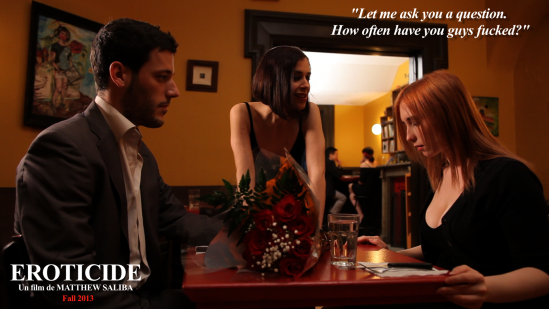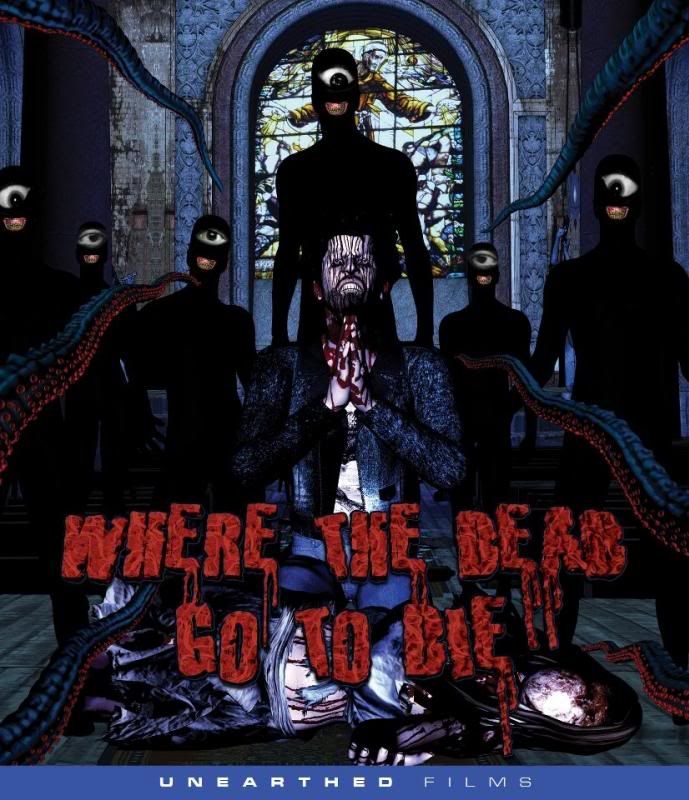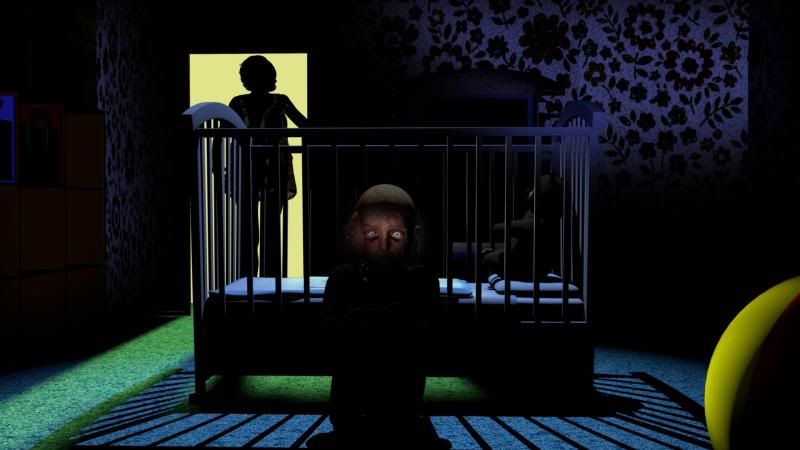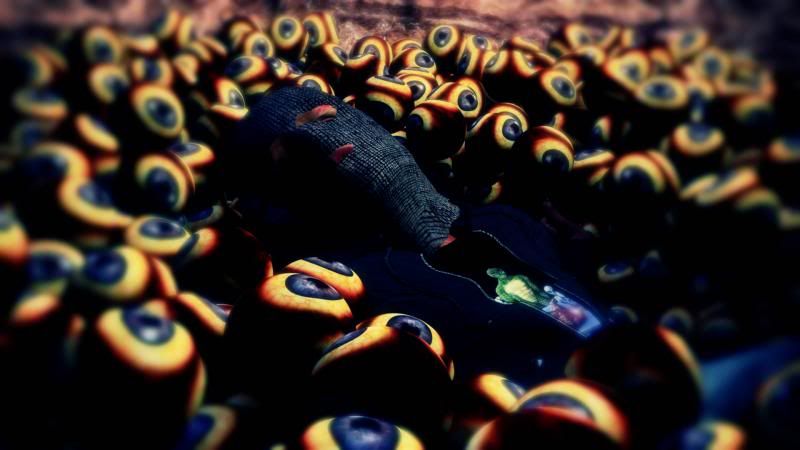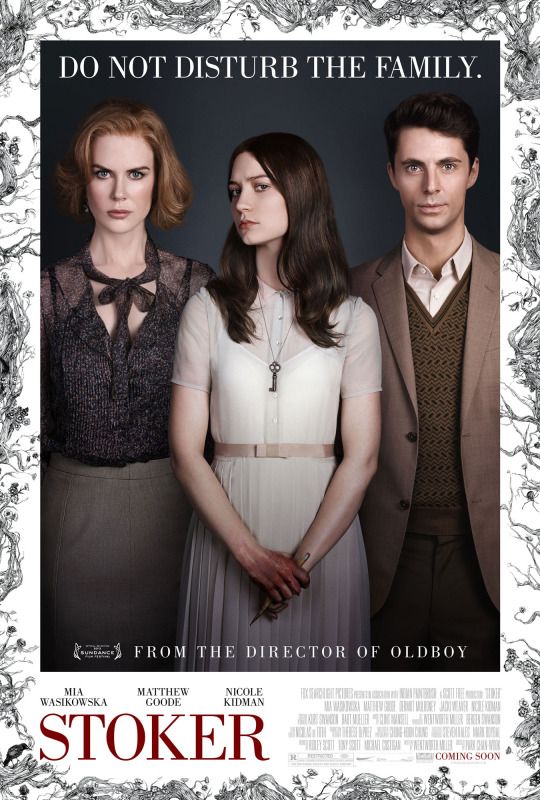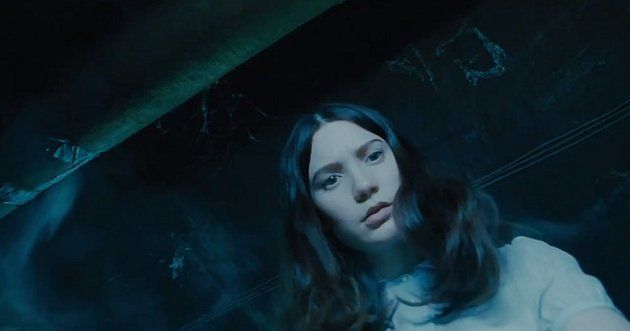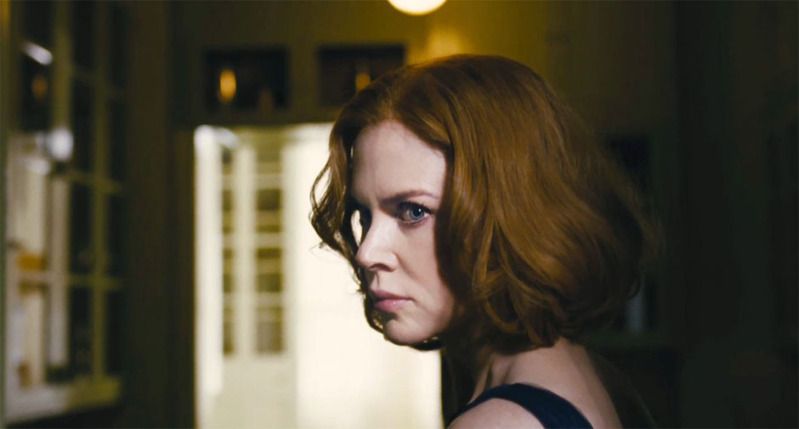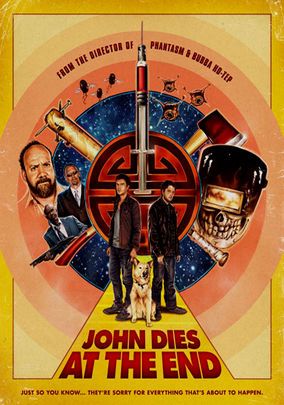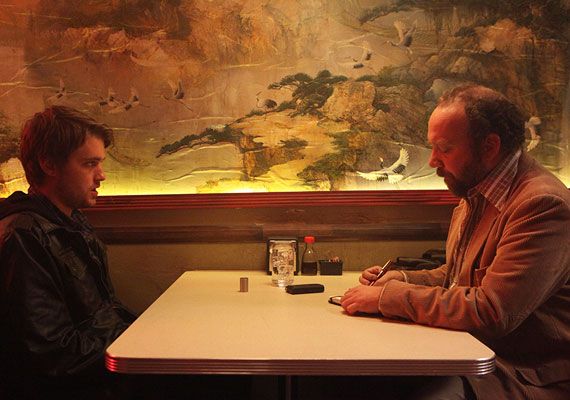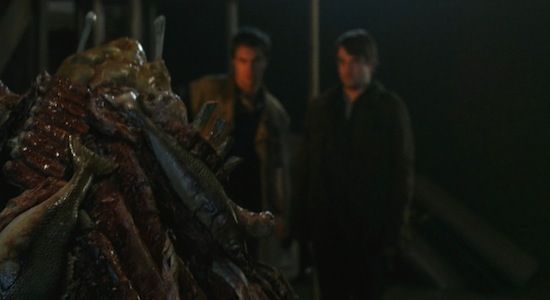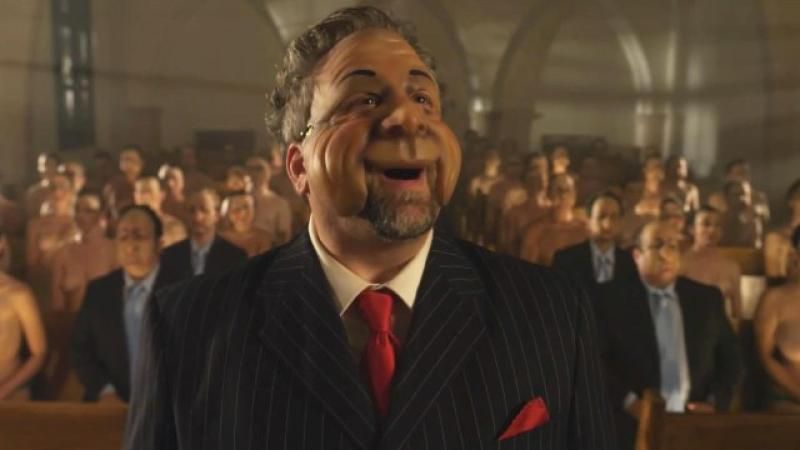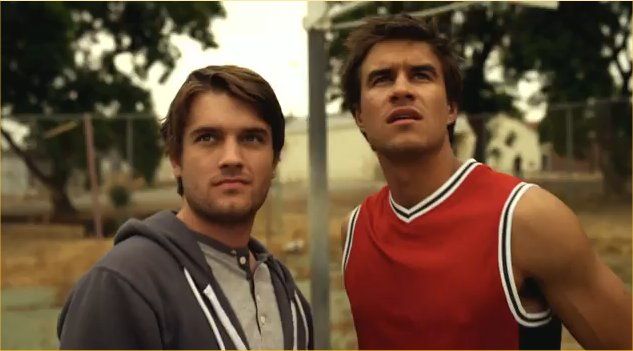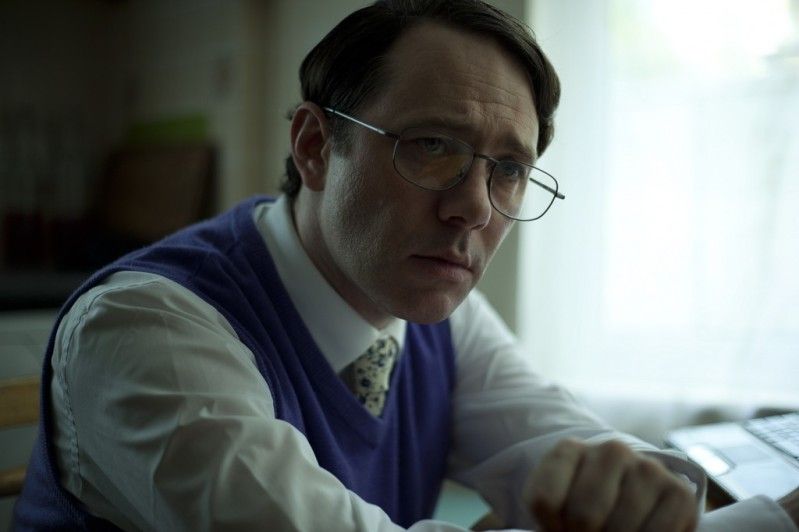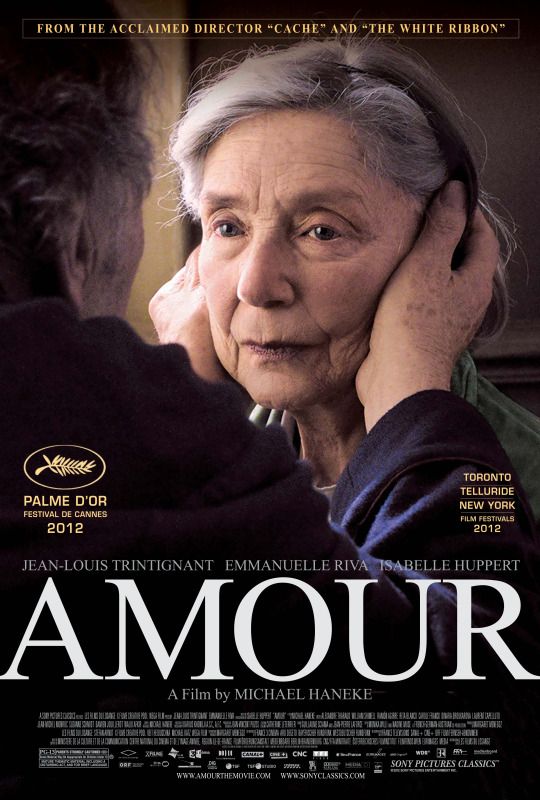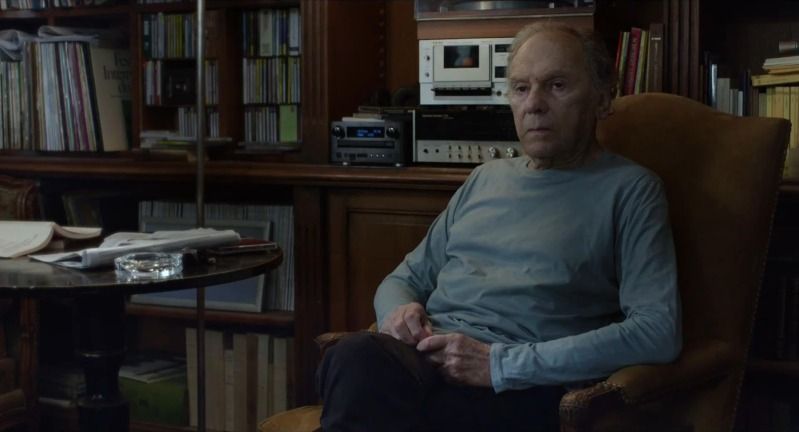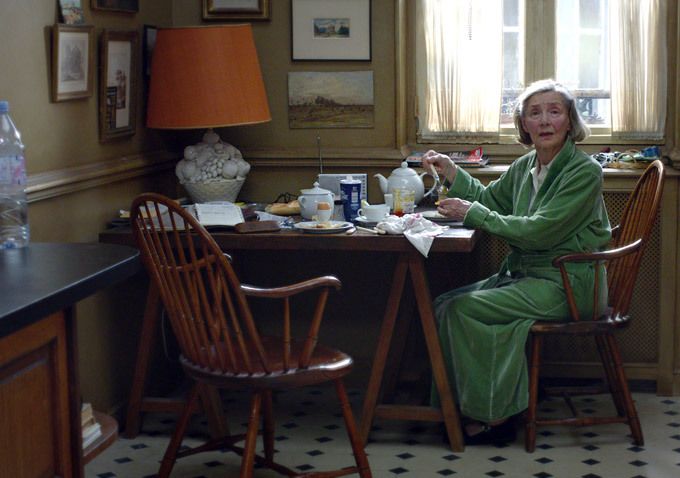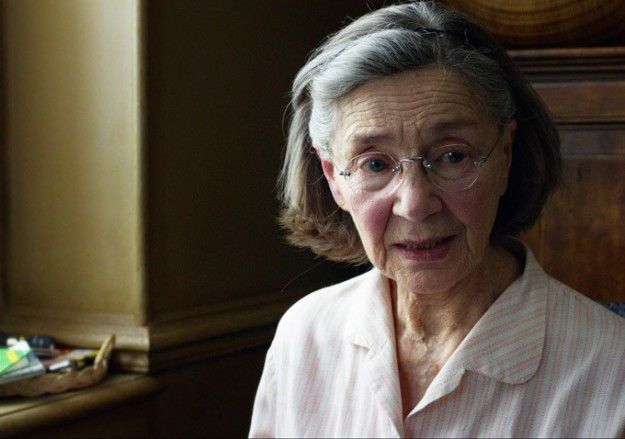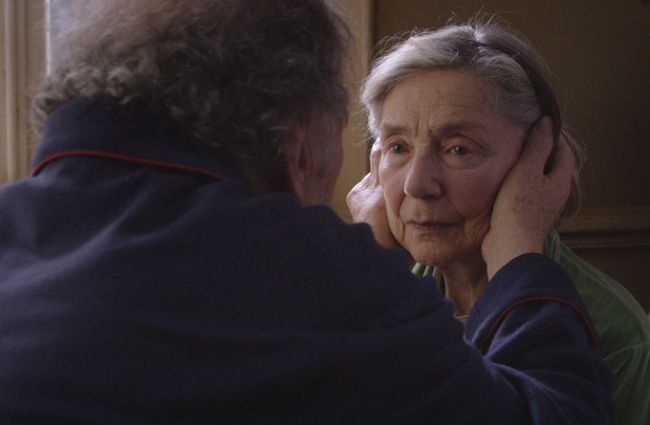9/5/13
Matthew Saliba's EROTICIDE: Dirty Little Secrets
Eroticide (2013)
Director: Matthew Saliba
Writer: Matthew Saliba, Andrée-Anne Saliba (French adaptation)
Featuring: Jocelin Haas, Stephanie van Rijn, Lisa Di Capa
Website: The Celery Stalks at Midnight
In the throes of desire, Yan (Haas), the male protagonist in Matthew Saliba's latest film Eroticide, recites mantras on command that throw around pointed words like "loser" and "pathetic"; each phrase - aimed at himself - indulges in self-abuse that affects not only his relationships, but engenders his entire being. Yan craves humiliation, and though he tries to bury these tendencies, he can't even get an erection without the assistance of an insult.
Yan and his girlfriend Elise (van Rijn) are prematurely celebrating an anniversary (they've only been together nine months) with a romantic dinner. They are rudely interrupted by Yan's imposing, foul-mouthed ex-girlfriend Kendra (Di Capa) who bullies both Yan and Elise on their special night. Elise, patient and forgiving, gives Yan another shot; soon, however, Yan is fantasizing about the brutal kind of affection he's only ever received from the unmerciful Kendra.
Eroticide is a deeply intimate look at the complex inter-relationships between these three characters: Yan is a self-loather who yearns to be dominated, demonstrated by his words ("I am a pathetic loser") and actions (licking Kendra's shoes); Kendra finds great pleasure in humiliating Yan, yet doesn't realize - as a person who gets off on dispensing humiliation - she needs Yan just as much as he needs her; Elise's concept of love inhabits its own extreme end of the relationship spectrum, manifesting as harm to herself as a demonstration of her devotion to Yan. The exploration of this sado-masochistic threesome benefits from the richness of Saliba's dialogue; rather than sink into cheap exploitation, his command of the material, and respect for the neuroses of his characters, elevates the story to thought-provoking levels.
Yan's story, told through the lens of an empathetic Saliba, explores the definition of "healthy" relationships in a world where damaged souls rely on delicate connections; they may unravel once troubling secrets are brought to light. When deep-seated psychological idiosyncrasies are unearthed, the lines between "healthy" and "unhealthy" become blurred when it comes to love and sex. Despite the short format, Saliba manages to convey the cyclical nature of abusive relationships, as well as the co-dependency wrought from whatever attraction keeps the abused coming back for more. Better yet, Saliba is not passing judgement on any of these characters; he's merely portraying them in their rawest, most vulnerable state - for better or worse.
Two things stand out in Saliba's film: The first is the refreshing lack of a music score; each scene thrives on genuine emotion without the manipulation of musical cues to coerce viewer experience; The second is Saliba's gimmick free cinematography that utilizes mostly static shots with a focus on body language, as well as the spoken (French and English) and unspoken (passive aggression) languages passing between the characters. Sometimes the language encourages; other times it berates; but throughout it's always the language of desire, no matter how twisted it might become.
It's always a treat to witness a new Sinema Saliba film; with each production, director Matthew Saliba (Vampyros Lesbos, Amy's in the Attic) pushes the envelope of genre cinema with genuinely provocative ideas; he and his small troupe of fearless actors - here with Haas, van Rijn, and Di Capa respectively - transcend the challenges of micro-budget efforts while defying the cliche-ridden landscape of cinema. With every production, it's clear that Saliba establishes trust with his players; he's able to coerce engaging, yet uncomfortable interactions between them. These moments subsequently position the viewer face to face with his or her own inner demons; the result can be therapeutic if we're able to embrace the truths about our own psyches.
EROTICIDE Trailer
6/25/13
WHERE THE DEAD GO TO DIE: Animate and Devastate
Where the Dead Go to Die (2012)
Director: Jimmy ScreamerClauz
Writer: Jimmy ScreamerClauz
Cast: Ruby Larocca, Joey Smack, Linnea Quigley, Trent Haaga, Devanny Pinn
Website: http://www.deadlyproductionsrecords.com/wtd.html
Animated films possess the ability to push boundaries like no other artform; the limitations exist only in the imaginations of the creators. From Émile Cohl's ghostly chalk-line images in 1908’s Phantasmagoria, to the grotesque works of stop-motion animator Robert Morgan (Bobby Yeah!, The Cat with Hands), horrific animated films exist to provoke and startle in a medium that transcends notions of being made "just for kids". Adults will find plenty of provocative material to mine in the realms of stop-motion, hand-drawn, or in the case of this review's subject, shaky computer generated animation.
Animation may have been the only viable forum for Jimmy ScreamerClauz (The Bunnyman) to tackle the miserable themes he’s chosen to examine in his crudely animated, but deeply disturbing feature Where the Dead Go to Die. Curiously, the aesthetic of WTDGTD is akin to the primitive block 3D style of 90's video game “cinema” scenes, an artistic choice that may, at the outset, incite more laughter than screams. It's unclear if this is a deliberate choice by ScreamerClauz, or if he's still familiarizing himself with digital tools; this facet of the film will undoubtedly receive the toughest criticism. It can be argued, however, that the occasionally inane look was an effective way of rendering the massively depressing material more palatable, and succeeds in providing an unnervingly surreal quality to the film. It’s only partially a joke to say that the crude format may be the only way this kind of material – elements of child prostitution, bestiality, and unfettered bloodshed – can legally exist at all.
ScreamerClauz’s film is fashioned from three interconnected stories (Tainted Milk, Liquid Memories, The Masks That Monsters Wear) set in a ramshackle neighborhood on the outskirts of town. It’s a place that exists everywhere, one where addiction, poverty, and abuse prevail, and moments of lucidity are fleeting for those trapped in the clutches of despair. Dark evil not only pervades, it radiates, infecting those on the fringe. As one character explains, it’s a place that serves to “balance” the world of light and dark, life and death. Darkness and death are, indeed, omnipresent, and the monsters dwelling here are very real.
Child characters are the focal point of the film, the structure woven from their horrible stories, and intertwined by visits from a demonic dog named Labby. Tommy is a young boy driven to committing vile acts against his parents, persuaded by Labby that his pregnant mother is carrying Satan’s child. Ralph, a boy born with a horrible deformity, harbors an adolescent crush somewhere between lust and obsession that makes him susceptible to Labby’s sadistic whims. Sophie, the only victim not given a choice by Labby, lives a life of cruel exploitation, prostituted by her twisted father in a child porn operation. Each child's suffering connects them in a heartbreaking union of inescapable misery, one that transcends space and time. ScreamerClauz’s storytelling here, consequently, manages to massacre a familiar slice of comforting Americana – a boy (or girl) and his (her) dog.
ScreamerClauz overcomes the obstacles one might attribute to the “primitive” technological tools by going full tilt with the imagery; no one can accuse him of not going far enough in the graphic depictions of carnage. Torture, rape, and other atrocities litter an overwhelmingly sadistic environment replete with vicious and visceral imagery. It’s twisted, gory, subversive stuff, yet profound in its ability to seep beneath the skin of the viewer despite technical flaws that should dilute the content. Better yet, it isn’t completely nihilistic; there are fleeting moments of sublime joy shared temporarily between the characters. For example, Ralph spends time with his crush Sophie in a beautiful garden, a moment shattered by Sophie’s realization that she must get home before her father "misses" her.
It’s difficult to recommend a film comprised of such wretched, painful material, especially considering the unsophisticated aesthetic employed by ScreamerClauz. It would, however, be a mistake to dismiss Where the Dead Go to Die on those grounds. It’s a film that at its core is one of the most purely horrific films released in some time. By pushing the limits on what is acceptable in film and animation, it opens up new and relevant avenues of discussion for confrontational cinema. It’s certainly not for everyone. It may not be for anyone. Yet it’s a film that absolutely shouldn’t be ignored by those open to the challenges of ScreamClauz’s literal and figurative demons.
Where the Dead Go to Die Trailer
4/4/13
BUFF Recap - Opening Night, Night 2 (I Declare War, The Manson Family, A Band Called Death, Guilty of Romance)
 |
| A Band Called Death |
Opening Night: I Declare War (2013), The Manson Family (2003)
 |
| I Declare War |
Following up was the re-release of James Van Bebber's shocking The Manson Family, marking its 10th anniversary. The Manson Family is part fictional narrative, part documentary, and a savage imagining told through the eyes of Manson's most recognized cult members. Van Bebber's dizzying grindhouse-era aesthetic is one for which Rob Zombie reaches, but never quite grasps. This film - particularly the third act - will haunt you.
Night 2: A Band Called Death (2012), Guilty of Romance (2011)
 |
| Guilty of Romance |
Sion Sono concludes his "Trilogy of Hate" with Guilty of Romance, a provocative examination of Japanese culture and the roles of women within a constrictive society. As usual, Sono's film is brazen and beautiful, but requires the viewer crack the codes of his lyrical delivery of challenging themes. You can read my Full Review over at Diabolique Magazine's website.
Recaps of the remainder of BUFF's programming on the way including Cheap Thrills, See You Next Tuesday, White Reindeer, Saturday Morning Cartoons, Jug Face, and BIG ASS SPIDER!
3/25/13
Help Genre Icon Karen Black Battle Cancer
Here's an opportunity to give back to a genre icon who has graced screens both large and small. Karen Black, the incredibly talented star of Day of the Locust, Trilogy of Terror, and Easy Rider, is currently battling a very serious form of cancer. She and her family are raising money to help with expenses associated with cancer treatment. Please consider donating to her campaign to help restore the strong, captivating presence we all adore.
3/23/13
Harmony Korine's SPRING BREAKERS: Party 'til You Die
Spring Breakers (2013)
Director: Harmony Korine
Writer: Harmony Korine
Cast: Ashley Benson, James Franco, Selena Gomez, Vanessa Hudgens, Rachel Korine, Gucci Mane
Website: Spring Breakers Official Website
In Harmony Korine's Spring Breakers, shaman-like OG Alien (James Franco) utters the mantra "spring break forever" in an ethereal tone that echoes throughout the film. His words are the lynchpin between two colliding yet converging worlds. The participants in those worlds are each living a fantasy life with a fast approaching expiration date; the difference is that one group has the ability to escape that world whenever they chose, while the other is trapped by circumstance.
College friends Faith (Gomez), Candy (Hudgens), Brit (Benson), and Cotty (Korine), a group of pretty blondes (and one brunette), are a few dollars short to make it down south to St. Petersburg, Florida for Spring Break. The obvious solution is rob a local restaurant for the loot, one performed with aplomb by the ennui-stricken girls. Each is looking for a life changing experience among the partying crowds of the beaches and clubs, and find a world ready to embrace their pent up emotions and lust for ACTION. When they land in jail after a drug raid, Alien bails them out and takes the enthusiastic crew on a violent voyage into his world of hustling, guns, and drugs.
A superficial look at Korine's multi-layered film would have you believe this is just a Girls Gone Wild video taken to the utmost extremes. That couldn't be more inaccurate. Sure, the film is filled from beginning to end with tanned naked bodies, rampant drug use, and violence, but peeling those layers reveals an affecting examination of intersecting cultural, economic, and existential themes. The film is actually a rather complicated piece of filmmaking once those conversation threads are breached.
College kids descend like a plague upon communities like St. Petersburg, stripping the towns to the bone. Conversely, these communities are dependent upon a tourism trade that requires them to look the other way as privileged young adults yearning for "freedom" or "release" do so under a veil of perceived consequence-free debauchery. On the outskirts lie the people born and raised in those communities whose only chance of survival is in benefiting from the destruction. Like the four horsemen of the apocalypse, our four young protagonists - deemed "special" by Alien - penetrate the fringes where people like Alien and his rival Archie (Gucci Mane) battle for control of the illicit profits and the infinite perpetuation of gangster culture. This subculture is now in danger of succumbing to the same fate that befell the city around it.
Disney star Gomez as the wholesome Faith is the only character given any sort of depth, and for a reason. Her character is the only one with plans for genuine soul-searching. She, however, heads home quickly when things get too uncomfortable. The rest of the characters live in a state of arrested development, opting instead to take Alien literally on his offer to live like it's Spring Break forever. Already having it all, they now want Alien's lifestyle - a house full of guns and money - because nothing else could possibly be fulfilling. As he puts it, "this is the American dream".
The interchangeability of the remaining female characters plays into Korine's challenges to pop culture and its rotating cast of used child stars, co-opted culture (hip-hop in particular), and other forms of throw-away exploitation. His casting of child-stars Gomez and Hudgens, as well as running tributes to Brittney Spears serves to drive his point that innocence is not only lost, but it's been taken out back behind a shed, shot in the head, and buried in an unmarked grave while the next "big thing" is trumpeted just above the freshly buried corpse.
Part of what makes Spring Breakers fascinating is the sumptuous visuals provided by Benoit Debie (Irreversible) who contrasts the frenetic party scenes with periods of wondrous beauty. This can be shots of the setting sun on a beach, or just the image of the four girls playfully contorting their bodies in silhouette against the walls of narrow hallways and breezeways. These are the moments when the characters feel most human with a world truly open to possibility. These moments are also fleeting...
The scenes of violence employed by Korine may seem over-the-top, but it's a clever way to subvert expectations. These girls commit crimes without remorse or fear, believing that they do, indeed, rule the world. They do so brazenly, right in the faces of their victims, believing every second that they are invincible. In this extreme and satirical way, Korine is contrasting their behavior with that of politicians, corporations, entertainers, and the like that anonymously do the same. These are the children of those so-called leaders who will grow up to replace them in their pursuit of money, money, money. Think of Spring Break as depicted here an internship for the larger crimes surely to characterize their career trajectory.
Spring Breakers Trailer
3/21/13
Cinedelphia disturbs with VIVISECTIONS on April 14
Cinedelphia - the portal to the best cinema in the greater Philadephia area - has launched their own festival to celebrate the rich film history of the City of Brotherly Love. The Cinedelphia Film Festival takes place from April 4 - 27 featuring the best films with a Philadelphia connection.
Part of the event is a special presentation of subversive films entitled Vivisections, programmed by area filmmaker Matt Garrett. Mr. Garrett has collected some of the most challenging, brutal, and brazen films from all over the globe. Each sinister film is hand-picked to startle, disturb, or arouse. All selections are Philadelphia premieres.

Titles include Karen Lam's The Stolen (2012), a fairy tale gone horribly awry when a young girl helps out the wrong fairy princess. Sam Walker's Bite Horse (2012) is a nightmarish music video featuring the unnerving sounds of the band Mississippi Witch. Maude Michaud's RED (2012) is a stunning cinematic crossroads where erotica meets the snuff film. Greg Hanson and Casey Regan's Meat Me in Plainville (2011) blends Soylent Green with the sensibilities of a 50's sitcom. Josh MacDonald's Game (2012) is a satirical take on backwoods hillbilly survivalist fare, and Matt O'Mahoney's Adjust Tracking (2012) puts a neat VHS spin on bloody revenge flicks. These are just a sample of the horrible treats in store for Philadelphia area fans of provocative film.
Below is Cinedelphia's Official Press Release with ticketing info, dates/times, more film descriptions, and a few trailers:
CFF: VIVISECTIONS International Short Horror Films
THE CINEDELPHIA FILM FESTIVAL presents
Sunday, April 14 2013, 9:30 PM
VIVISECTIONS: International Short Horror Films Program
 Voyeurism,
snuff, cinema and sex collide in Red, a provocative slow-burn shocker
from Montreal horror maven, Maude Michaud (Hollywood Skin). In Rafael
De Leon Jr's Birthday Boys, teenaged Riley turns to dark forces in order
to bring back her lost love. Cinematic madman Sam Walker (Tea Break)
presents his short film/music video hybrid Bite Horse, the first chapter
of a multi-media collaboration with the Southern Gothic band
Mississippi Witch. Next is Doll Parts and Stained director Karen Lam's
The Stolen, a dark fairy tale about a young girl with a big heart who is
forced to strike a bargain ur program concludes with the stop-motion
animated nightmare, Crépuscule, from visionary director Éric Falardeau
(Thanatomorphose). A young woman, bound at the wrists, attempts to
escape her demented redneck captors in screenwriter Josh MacDonald's
(The Corridor) beautifully photographed and wickedly funny directorial
debut, Game. Aussie director Dave Wade's slick, sick and hilariously
crude A Tale of Obsession follows an overweight teen goth as she
attempts to curb her hunger to win the heart (and body) of the
perpetually shirtless school hunk. Matt O'Mahoney, director of the
Fantastic Fest award-winning Electric Fence, returns with Adjust
Tracking, a lovingly meaty homage to the Golden Age of VHS Horror. And
finally, from the delightfully twisted minds of Greg Hanson & Casey
Regan (Thy Kill Be Done) comes the definitive argument against
USDA-approved cannibalism, Meat Me in Plainville. Think Soylent Green
meets I Drink Your Blood with a healthy dose of Father Knows Best thrown
in for good measure. Human Meat Is Murder!
Voyeurism,
snuff, cinema and sex collide in Red, a provocative slow-burn shocker
from Montreal horror maven, Maude Michaud (Hollywood Skin). In Rafael
De Leon Jr's Birthday Boys, teenaged Riley turns to dark forces in order
to bring back her lost love. Cinematic madman Sam Walker (Tea Break)
presents his short film/music video hybrid Bite Horse, the first chapter
of a multi-media collaboration with the Southern Gothic band
Mississippi Witch. Next is Doll Parts and Stained director Karen Lam's
The Stolen, a dark fairy tale about a young girl with a big heart who is
forced to strike a bargain ur program concludes with the stop-motion
animated nightmare, Crépuscule, from visionary director Éric Falardeau
(Thanatomorphose). A young woman, bound at the wrists, attempts to
escape her demented redneck captors in screenwriter Josh MacDonald's
(The Corridor) beautifully photographed and wickedly funny directorial
debut, Game. Aussie director Dave Wade's slick, sick and hilariously
crude A Tale of Obsession follows an overweight teen goth as she
attempts to curb her hunger to win the heart (and body) of the
perpetually shirtless school hunk. Matt O'Mahoney, director of the
Fantastic Fest award-winning Electric Fence, returns with Adjust
Tracking, a lovingly meaty homage to the Golden Age of VHS Horror. And
finally, from the delightfully twisted minds of Greg Hanson & Casey
Regan (Thy Kill Be Done) comes the definitive argument against
USDA-approved cannibalism, Meat Me in Plainville. Think Soylent Green
meets I Drink Your Blood with a healthy dose of Father Knows Best thrown
in for good measure. Human Meat Is Murder!Every film in this program is a Philadelphia Premiere, having previously played such festivals as Cannes, Fantasia, PiFan, Sydney Underground,and Fantastic Fest.
Advance tix are $10, no refunds or exchanges.
The Cinedelphia Film Festival is a Philly-centric celebration of Philly film running from April 4-27, 2013.
http://www.cinedelphiafilmfestival.com
Trailers
Game Trailer
The Stolen Trailer
Birthday Boys Trailer
RED Trailer
Crepuscule Trailer
3/4/13
Park Chan-wook's STOKER: Portrait of a Fractured Family
Stoker (2013)
Director: Park Chan-wook
Writer: Wentworth Miller, Erin Cressida Wilson (contributing writer)
Cast: Mia Wasikowska, Nicole Kidman, Matthew Goode
Website: Stoker Official Site
Alfred Hitchcock's Shadow of a Doubt may be the impetus for Park Chan-wook's first English-language film Stoker, but the film moves about with a dreamy fairy-tale quality that distinguishes itself from the master of suspense's classic. It's the result of Chan-wook's unique ability to imbue poetic lyricism into his stylish thrillers. Once again working with cinematographer Chung-hoon Chung (Oldboy, Lady Vengeance), the two have crafted a stark gothic tale full of strange beauty and sudden violence.
India (Mia Wasikowska) and her mother Evelyn (Nicole Kidman) have just lost their family chieftain Richard Stoker (Dermot Mulroney) to a fiery auto accident. In the midst of coming to terms with the loss of a father and husband, they are visited by his long-lost brother Charlie (Matthew Goode), an uncle India never knew existed. India is captivated by the charming renaissance man, driving further an already existing wedge between India and her mother. India's uncle soon reveals a sinister side, but India has her own darkness brewing, cultivated by the enigmatic Charlie.
Stoker is a psychological thriller with a simple premise, but one operating with spectacular character dynamics. Wasikowska (Alice in Wonderland) portrayal of India is a revelation. She's a young woman whose life - once enriched by her father's nurturing - is now left with a huge void. Evelyn, seduced by Charlie's eccentricities and many talents, will do anything to replace the hole in her own heart with Charlie as surrogate. Charlie is obviously a sociopath, able to inflict great pain and death with as much concern as opening a bottle of fine wine. He sees a chance to adopt his brother's flailing family as his own. Each performer rises above typical melodramatic histrionics by delivering nuanced, offbeat takes on their respective characters.
Class tension factors as a small undercurrent of Stoker. India's family appears to be the only financially stable in her community. Her time spent in activities like playing the piano or target shooting seem superfluous when contrasted with fellow blue collar, underachieving students at her school. This puts a distance between her and her classmates, and bullies taunt her as being "weird" or a "bitch". This gap allows Charlie to insinuate himself in India's life in a profound way. A pivotal scene follows India on a rendezvous with a local boy after his shift at a fast food joint. Their volatile encounter ends in bloodshed at the hands of Charlie in front of Inda, both of whom think little of offing the boy after he attacks India. India's compliance in the act - whether or not deserved by the boy - reveals that she has more in common with Charlie than could be imagined.
The final act culminates in the sort of mayhem most fans have come to expect of Chan-wook. While it may not live up to the expectations of some, it shows a director dedicated to the type of growth displayed in his last feature Thirst (2009). When most revenge thrillers are focused exclusively on the brutality, Chan-wook differentiates himself with complex emotional depth. In India, we see great potential thwarted by corruption and the influence of a terrible man. As Uncle Charlie says "she's of age", and though he never reveals what he means, the viewers knows for certain it won't be good. Perhaps the real cruelty operating here is the callous opportunism that rises from taking advantage of broken, abandoned hearts.
Stoker Trailer
2/27/13
Support the Boston Underground Film Festival in Their 15th Year
The Boston Underground Film Festival (BUFF to their friends) has been carrying the torch for subversive, groundbreaking cinema for the past 15 years. It's an astounding feat considering most of their selections are huge artistic risks taken by some of the most innovative and provocative independent filmmakers out there. Boston audiences starving for original and daring cinema need look no further than a short trek to our very own Brattle Theatre March 27 - March 31.
It's always exciting when BUFF reveals their latest selections, and this year's offerings finds them pushing the envelope to the point of bursting. Their first round of announcements include opening film I Declare War (a favorite at TIFF and Fantastic Fest), BUFF alum Zach Clark's (Modern Love is Automatic) Christmas-themed shocker White Reindeer, and E.L. Katz's thriller Cheap Thrills.
Other selections include Kristina Buozyte's emotionally-charged romantic sci-fi film Vanishing Waves, the documentary A Band Called Death about little-known Detroit proto-punk band Death, and Kim Ki-duk's crime-laden story of redemption Pieta. This small sample doesn't include all the wonderful short films, music videos, animations and other brazen works of cinematic art trumpeted by the hardworking folks at BUFF.
BUFF is also celebrating the 10 year anniversary of Jim VanBebber's astonishing The Manson Family (along with his new short film Gator Green). The graphic and controversial film was rarely seen during its initial run, and is getting a proper treatment for Boston filmgoers.
Your support is needed for BUFF's final push. Here are a few trailers to convince you, as if you needed it:
I Declare War Trailer
Vanishing Waves Trailer
A Band Called Death Trailer
The Manson Family Trailer
2/25/13
JOHN DIES AT THE END: A Not-So-Dynamic Duo Saves the World
John Dies at the End (2012)
Director: Don Coscarelli
Writer: Don Coscarelli (screenwriter), David Wong (original story)
Cast: Chase Williamson, Rob Mayes, Paul Giamattil, Clancy Brown, Fabianne Therese
Website: John Dies at the End Official Site
No genre filmmaker had a better pedigree to pull off the earnest weirdness of David Wong's John Dies at the End than Don Coscarelli. The book reads like a hyperactive 80's monster movie mashed up with Buckaroo Banzai if written by Fear & Loathing era Hunter Thompson. Coscarelli, the madman behind Phantasm and Bubba Ho-Tep, is no stranger to bringing bold and bizarre visions to the big screen. His skill lies in keeping the chaos controlled and fluid, yet complimentary to Wong's (in real life Jason Pargin) charming metaphysical disorder.
David Wong (Chase Williamson) sits down in a Chinese joint to chat with journalist Arnie Blondestone (Paul Giamiatti) about his experience with a drug called soy sauce. The oozing black substance - a dose taken accidentally by David - has given him and his buddy John (Rob Mayes) the phenomenal ability to read thoughts and transcend space and time, which is kind of a big deal for a couple of slacker college drop-outs. The unfortunate side effect is that it opens up doors for inter-dimensional monsters to wreak havoc in this world. David and John - together with the support of a lovely cast of misfits - become unwitting saviors destined to save the world from a monstrous entity called Korrok. That is, if they can get their shit together.
John Dies at the End is a triumph of cohesion over pandemonium. It was quite a feat to wrangle the basic concept of Wong's story while retaining all the offbeat, genre-meshing elements that made it so extraordinary. For all its multi-tentacled reaching, Coscarelli keeps everything grounded with a couple of very likable anti-heroes, and a semblance of a blueprint to keep the mania together and moving with a distinguishable purpose. Coscarelli serves up mutant worms, meat monsters, and parallel worlds as if they are minor inconveniences to John and Dave's (mostly John's) partying, rocking out, and girl-chasing. It's all strung together with an infectious reverence for the material, as well as the desire for the audience to have a shitload of fun.
Coscarelli's film is brazenly humorous and surreal but also serves as an amusing allegory for drug culture. David remarks that the immediate side effects of the soy sauce may wear off, but the effects of the drug will be with him forever. A terrifying scene of the aftermath of the mass overdose of a group of teens downplays the more playful aspects of the film. The film, however, never gets weighed down by some of the heavier elements that could be applied to the narrative. Instead, Coscarelli's work is a trippy funhouse ride punctuated with some genuine moments of dread, plenty of inventive gruesomeness, and quick-witted dialogue that honors Wong's voice from the book.
Coscarelli overcomes limitations in some arenas with genius casting of cult icons, including Clancy Brown as celebrity medium Albert Marconi, Paul Giamatti as the perplexed journalist Arnie, and a wonderful cameo by Angus Scrimm portraying a priest with therapeutic advice for David. Every member of the cast embraces the material, and delivers their roles with aplomb. Their inclusion and solid commitment is a testament to the effort put forth by Coscarelli to make John Dies work for everyone. Acclaimed Special Makeup Effects artist Robert Kurtzman populates the world(s) around them with creepy, slimy, long-limbed and toothsome beasts that would feel right at home alongside some of the 1980's most innovative creatures.
David - though his exterior is that of a skeptic - remarks that the sauce chose him because his mind was open. That's exactly how audiences should approach John Dies at the End. Not everyone will leave understanding what's transpired onscreen, and that's ok. Much like the lovable team of losers portrayed in the film, viewers should just succumb to Coscarelli's kooky apocalyptic vision. Fans trusting in his dose of cinematic soy sauce will have them clamoring for more mind-shattering adventures with David and John.
John Dies at the End Trailer
2/23/13
Paul Davis' HIM INDOORS: Caught in the Act
Him Indoors (2012)
Director: Paul Davis
Writer: Paul Davis
Cast: Reece Shearsmith, Pollyanna McIntosh
Website: Him Indoors Official Site
I have my friend Matt Garrett to thank for directing me toward Paul Davis' Him Indoors. It's a hilarious reverse of the Sigourney Weaver serial killer vehicle Copycat (1995). Instead of Weaver's sympathetic phobic, however, we find a psycho afraid to leave his own home. It's a playful, but dark film that is available to watch for free on FearNet.
Reece Shearsmith (Shaun of the Dead) portrays Gregory, a man meek in appearance, but harboring a monster inside that kidnaps and kills hapless victims lured to his apartment. His life confined to his home makes murder a challenge, but alleviates his crushing agoraphobia. Enter Lizzie (Pollyanna McIntosh), Gregory's intrusive neighbor, who unknowingly barges in on his freshest kill. She cavorts around Gregory's pad none-the-wiser despite evidence of foul play.
Pollyanna McIntosh, fresh off a wave of tremendous success with Lucky McKee's The Woman gets to show off her versatility with impressive comedic chops. Her performance is the perfect foil to Shearsmith's squirrely Gregory. The two have tremendous chemistry, and really give the simple premise the punch it needed to overcome any limitations in budget or location.
Paul Davis' screenplay and direction is focused, and every component needed to make an effective short is on display here. The blend of horror and comedic awkwardness is an effective way to capitalize on the success of similarly formatted situation comedies, but with that demented touch horror fans embrace. Him Indoors is an impressive treat, and evidence that this trio should work together again.
Him Indoors Trailer
2/22/13
Michael Haneke's AMOUR: Tragically Enduring Love
Amour (2012)
Director: Michael Haneke
Writer: Michael Haneke
Cast: Emmanuelle Riva, Jean-Louis Trintignant, Isabelle Huppert
Website: Amour Official Site
Austrian filmmaker Michael Haneke (The White Ribbon) loads his films with such crushing despair, it's surprising he hasn't suffocated most of his fans in utter misery. The auteur has been forcing the highbrow art house crowd to face their own mortality throughout his varied career with powerful, bleak films like Cache and Time of the Wolf. He's taken to that task quite literally in his latest offering Amour, a precision-perfect snapshot of love strained in the face of impending death. Haneke, often criticized for a "cold" and "emotionless" body of work removes those descriptors from the conversation by delivering a heartfelt - though no-less-provocative - piece examining the paralyzing frustration of witnessing a loved one suffer. Perhaps in response to his detractors, he handles it with a gentleness uncharacteristic of the man responsible for the desolate Funny Games.
Amour is the story of Georges (Jean-Louis Trintignant) and Anne (Emmanuelle Riva), an aging couple content in their lifelong commitment to one another. Both have led successful lives as music instructors, and have a well-adjusted daughter named Eva (Isabelle Huppert), a professional musician.Their bond is tested when Anne suffers a stroke, and succumbs to degenerative health conditions spurred by her advanced age. The film focuses on Georges' efforts to give Anne dignity in her decline. It's a task that becomes increasingly more challenging as Georges contends with the intervention of doctors, nurses, and his own family, all of whom are very removed from the worst of Anne's daily physical and psychological anguish.
Audiences familiar with Haneke's filmography are aware that he rarely uses a music soundtrack to invoke or manipulate emotional responses to scenes in his films. Never is the exclusion more apparent than in Amour. Though the film revolves around the music rich lives of its central characters, any accompaniment is incidental. Amour is the most emotionally raw and affecting of all his films. This is primarily because Georges and Anne are such sympathetic and relatable characters. Audiences of all ages can identify with Georges' efforts to make Anne more comfortable in her state. Conversely, we're stricken by Anne's struggle to maintain control over her mind and body. Trintignant and Riva are so wholly convincing in their portrayals that viewers will feel they are intruding on profound moments of intimacy shared between genuine people.
Haneke, always game for subverting convention, keeps his narrative fairly straightforward. There are no excessive long takes or characters breaking the fourth wall, so any accusations of gimmickry aren't applicable here. Instead, Haneke relies solely on the power of his actors, framed beautifully by cinematographer Darius Khondji (Midnight in Paris). As usual, Haneke tells his tale with stunning compositions that squeeze profundity from the most mundane acts. One distressing scene, for example, takes place during an innocuous moment of two people sharing tea. It's a pivotal moment in the film, and the viewer is caught totally off guard.
Though Haneke denies the inclusion of pigeons in the film as holding any symbolic significance, the once domesticated bird pops up in several important scenes. One instance shows Georges helplessly chasing a stray pigeon around the apartment before covering the pigeon with a blanket. His next act can be construed as either cradling or smothering the hapless bird, but Georges' action - much like Haneke's film - remains ambiguous. The same can be said of the climax that leaves itself open to interpretation despite an apparent finality.
From the outset, Georges' efforts to care for Anne, though futile, are powered by his unwavering love. Not one moment is spent in self-pity. He is steadfast in honoring Anne's request to remain home and out of hospitals. It's a responsibility very few would take on, particularly when Anne reverts to an infant-like state. Georges' outbursts of cruelty - though inexcusable - are at least somewhat justifiable. Even a severe final act elicits not horror, but understanding delivered with Haneke's trademark merciless honesty.
Subscribe to:
Posts (Atom)

